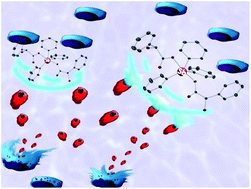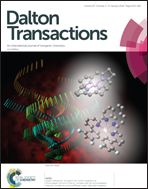Comparative stability, toxicity and anti-leishmanial activity of triphenyl antimony(v) and bismuth(v) α-hydroxy carboxylato complexes†
Abstract
A series of triphenyl Sb(V) and Bi(V) α-hydroxy carboxylato complexes of the general formula [MPh3(O2CROH)2] and [MPh3(O2CRO)] have been successfully synthesised and characterised, and subsequently assayed for their comparative activity towards Leishmania parasites and human fibroblast cells. Four complexes are novel; [SbPh3Gly], [BiPh3(GlyH)2], [SbPh3(R-ManH)2] and [SbPh3(S-ManH)2], and have been structurally characterised through X-ray diffraction. These were combined in the study with the known complexes; ([SbPh3(R-Man)], [SbPh3(S-Man)], [BiPh3(R-ManH)2], [BiPh3(R-ManH)2], [SbPh3(BenzH)2], [BiPh3(BenzH)2], for which the crystal structures of [BiPh3(S-ManH)2] and [BiPh3(R-Man)2] have now been authenticated (GlyH2 = glycolic acid, R/S-ManH2 = mandelic acid, BenzH2 = benzilic acid). The complexes adopt a typical bipyramidal 7-coordinate geometry with the phenyl rings occupying the equatorial plane, and the ligands on the axial. In contrast to previous studies the Bi(V) compounds show a relatively high degree of stability in DMEM culture media. Promastigote and human fibroblast cell assays showed the Bi(V) analogues to be non-selectively toxic with a respective IC50 range of 3.58–6.33 μM and 5.83–7.01 μM. In contrast, the Sb(V) analogues provided much greater selectivity (promastigotes 12.5–20.7; fibroblasts 72.8–≥100 μM). Assessment of the Sb(V) complexes against amastigotes at 10 μM showed them to be effective with % infection values ranging from 9.5 ± 0.5–30 ± 1.3.



 Please wait while we load your content...
Please wait while we load your content...